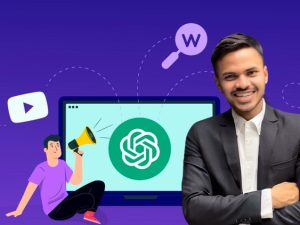Spring Boot with Rest API, MVC and Microservices
- Description
- Curriculum
- FAQ
- Reviews
The course is designed for Java beginners keen to learn Spring Boot from Basics.
It is designed and taught in such a way that beginners can easily grasp and code their own Spring Boot applications with minimal effort.
Spring Boot is a powerful framework for building Java-based applications, providing developers with a streamlined and opinionated approach to application development. Combined with Spring’s extensive ecosystem, it offers a comprehensive solution for building a wide range of applications, including RESTful APIs, MVC web applications, and microservices architectures.
REST API Development with Spring Boot: Spring Boot simplifies the creation of RESTful APIs by providing built-in support for various features such as:
-
Annotation-driven programming model: Developers can use annotations like @RestController, @RequestMapping, and @GetMapping to define REST endpoints and handle HTTP requests.
-
Automatic JSON serialization/deserialization: Spring Boot automatically converts Java objects to JSON and vice versa using libraries like Jackson.
-
Embedded server: Spring Boot includes an embedded servlet container (e.g., Tomcat, Jetty) so that you can run your REST API as a standalone application.
-
Actuator endpoints: Spring Boot Actuator provides built-in endpoints for monitoring and managing your application, making it easy to monitor health, metrics, and other runtime information of your REST API.
MVC Web Application Development with Spring Boot: Spring Boot simplifies the development of MVC (Model-View-Controller) web applications by providing features such as:
-
Spring MVC framework: Spring Boot integrates with Spring MVC to provide a robust web framework for building web applications.
-
Convention over configuration: Spring Boot adopts sensible defaults and auto-configuration, reducing the need for manual configuration.
-
Thymeleaf, FreeMarker, or other template engines: Spring Boot supports various view technologies for rendering HTML templates in MVC web applications.
-
Static content handling: Spring Boot can serve static content (e.g., HTML, CSS, JavaScript) from the classpath or external locations.
-
Embedded web server: Similar to REST API development, Spring Boot includes an embedded servlet container for running MVC web applications as standalone applications.
Microservices Architecture with Spring Boot: Spring Boot is well-suited for building microservices-based architectures due to its lightweight nature and extensive support for distributed systems. Some key features for building microservices with Spring Boot include:
-
Spring Cloud: Spring Boot integrates with Spring Cloud to provide features like service discovery (e.g., Netflix Eureka), client-side load balancing (e.g., Ribbon), distributed configuration (e.g., Spring Cloud Config), and circuit breakers (e.g., Netflix Hystrix).
-
Externalized configuration: Spring Boot enables configuration to be externalized, making it easy to configure microservices independently of each other.
-
Containerization and orchestration: Spring Boot applications can be easily containerized using technologies like Docker and orchestrated with platforms like Kubernetes or Docker Swarm.
-
Resilience and fault tolerance: Spring Boot integrates with libraries like Netflix Hystrix to implement resilient microservices that can handle failures gracefully.
Overall, Spring Boot provides a comprehensive platform for building RESTful APIs, MVC web applications, and microservices architectures, offering developers a productive and efficient way to develop modern Java-based applications.
This course is a one-stop solution for all the Spring Boot technologies.
-
3Spring vs Spring BootVideo lesson
-
4Spring Initializr - Creating Spring Boot ProjectsVideo lesson
-
5Designing a simple Rest Controller with REST APIVideo lesson
-
6Understanding Maven - A project management / build toolVideo lesson
-
7Spring Boot Starters, Parents and Dev ToolsVideo lesson
-
8Spring Boot ActuatorVideo lesson
-
9Check Your UnderstandingQuiz
This quiz is designed to test your knowledge on the differences between Spring and Spring Boot, the use of Spring Initializr, Spring Boot starters, Spring Actuator, and the design of simple REST controllers. Each question is multiple choice, with one correct answer.
-
10RESTful Web Services / REST APIVideo lesson
-
11Understanding JSON, HTTP Methods and Postman ClientVideo lesson
-
12Jackson - Java and JSON BindingVideo lesson
-
13Spring Boot - Using Path VariablesVideo lesson
-
14REST API - Exception HandlingVideo lesson
-
15REST API - Global Exception HandlingVideo lesson
-
16REST API Design - Best PracticesVideo lesson
-
17Check Your UnderstandingQuiz
This quiz is designed to test your knowledge of RESTful web services, JSON, HTTP methods, the Jackson project, path variables, exception handling in REST APIs, global exception handling, using @ControllerAdvice, and REST API design best practices. Each question is multiple choice, with one correct answer.
RESTful web services are a popular way to build and consume web APIs using the HTTP protocol. This quiz will cover key concepts and best practices for designing and implementing RESTful APIs, handling JSON data, using the Jackson project for JSON processing, managing path variables in URLs, and implementing robust exception handling strategies including the use of @ControllerAdvice for global exception handling.
-
20Introduction to Hibernate/JPAVideo lesson
-
21Setting up Spring Boot project Hibernate/JPAVideo lesson
-
22Spring Boot - Hibernate/JPA with Create or SaveVideo lesson
-
23Spring Boot - Hibernate/JPA with Read OperationVideo lesson
-
24Spring Boot - Hibernate/JPA with Update and Delete - as part of CRUDVideo lesson
-
25Spring Boot - Hibernate/JPA - Creating Tables from Java CodeVideo lesson
-
26Check Your UnderstandingQuiz
Test your understanding with Hibernate/JAP with MCQs
-
36Overview of Spring SecurityVideo lesson
-
37Basic Security ConfigurationVideo lesson
-
38User Accounts Stored in DatabaseVideo lesson
-
39Storing encrypted passwords in the databaseVideo lesson
-
40Spring Security - Custom TablesVideo lesson
-
41Check Your UnderstandingQuiz
Test your knowledge on Spring Security
-
42Introduction to Spring MVCVideo lesson
-
43Introduction to Thymeleaf Template EngineVideo lesson
-
44Reading form data - Spring MVCVideo lesson
-
45Form Data Binding - Using Text BoxVideo lesson
-
46Form Data Binding - Using Drop Down List (Select Box)Video lesson
-
47Form Data Binding - Using Radio ButtonsVideo lesson
-
48Form Data Binding - Using Check BoxesVideo lesson
-
49Bean API Validation for Form ValidationVideo lesson
-
50Check Your UnderstandingQuiz
Test your knowledge in Spring MVC, Thymeleaf, etc.
-
51Overview of EMS - Spring MVC CRUD ProjectVideo lesson
-
52EMS - CRUD Project - Get List of EmployeesVideo lesson
-
53EMS - CRUD Project - Add EmployeeVideo lesson
-
54EMS - CRUD Project - Update EmployeeVideo lesson
-
55EMS - CRUD Project - Delete EmployeeVideo lesson
-
56Check Your UnderstandingQuiz
Test your knowledge in a CRUD paroject
-
57Introduction to MicroservicesVideo lesson
-
58Developing a basic microservices app using Rest Template - Part IVideo lesson
-
59Developing a basic microservices app using Rest Template - Part IIVideo lesson
-
60Service Registry and Discovery - Netflix Eureka Server - Part IVideo lesson
-
61Service Registry and Discovery - Netflix Eureka Server - Part IIVideo lesson
-
62Check Your UnderstandingQuiz
Test your knowledge on Microservices and their Implementation in Spring Boot

External Links May Contain Affiliate Links read more





